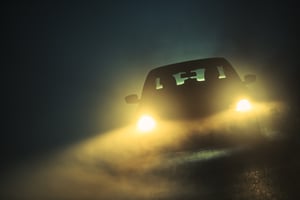 As we transition from winter to spring, you may encounter fog on your daily commute or while running errands. Fog occurs when Mother Nature mixes cold air and warm air, causing water droplets or ice crystals to float in the air. Depending on where you live and other factors, you may experience it more frequently than others.
As we transition from winter to spring, you may encounter fog on your daily commute or while running errands. Fog occurs when Mother Nature mixes cold air and warm air, causing water droplets or ice crystals to float in the air. Depending on where you live and other factors, you may experience it more frequently than others.
Whether you’re a seasoned veteran behind the wheel or a new driver, encountering fog can be stressful. It’s always a strange feeling when I’m on a familiar road, but the fog is so thick that I have no idea where I am.
Here are some tips to keep you and your family safe the next time you encounter fog on your journey.
1. Reduce your speed.
If you’re driving in fog, it’s critical that you slow down. Fog can reduce visibility so much that you can’t see what’s ahead, reducing your reaction time. Also, always keep an eye on your speedometer. Fog can cause disorientation when it comes to location and speed.
2. Watch the white line.
Use the white painted line on the right side of the road as a guide for proper lane positioning. In addition, watch for other roadside indicators, such as reflectors and signage.
3. Rely on your car’s low-beam headlights.
Low beams and fog lights provide the best visibility if driving in fog at night. If you’re like me, after driving in fog for a while, you may doubt yourself and flip on your high beams only to quickly realize they don’t help. Remember to turn on your headlights if you’re driving in daytime fog.
4. Relax.
Staying calm is important when driving in fog. If there’s a car in front of you, be patient. Road rage won’t do anybody good and could have severe consequences.
5. Don’t make unnecessary lane changes.
Because fog is disorientating, staying in your current traffic lane is your safest bet. Weaving in and out can be dangerous. If there’s an obstruction in the roadway, try to slow down significantly, then check blind spots before moving over.
6. Turn on your defroster.
Maximum visibility is critical when driving in poor weather. Using your defroster can keep your windows clear of internal fog. You don’t need it inside and outside. Don’t forget to turn on your windshield wipers as well.
7. Don’t use cruise control.
Like many other weather conditions, using cruise control in fog is dangerous. You simply don’t know what’s ahead. The last thing you need is cruise control to increase your speed as you go up a hill.
8. Apply gentle inputs.
Regarding steering and braking, small inputs can be safer and more effective in controlling your car. Drastic movements can cause your car to perform unfavorably and dangerously.
9. Watch for animals.
Like us, animals like deer can become disorientated and end up on the road before you. If this happens, apply significant pressure to your brake pedal. While your instinct may be to swerve, don’t do it. Swerving can put you in a more dangerous situation.
10. Use your hazard lights.
If you’re like me, you have difficulty finding the button when it’s time to use them. There are several important reasons to use your hazard lights. First, they provide more visibility to the cars approaching from the rear. In addition, they can alert other drivers that there’s a reason to be cautious and to slow down. Lastly, if you must pull over on the side of the road, turning them on is critical so others can see you. Remember, we’re all struggling with visibility.
Do you have any suggestions or information you’d like to share? I’d love to hear from you. Please share them in the box below.





